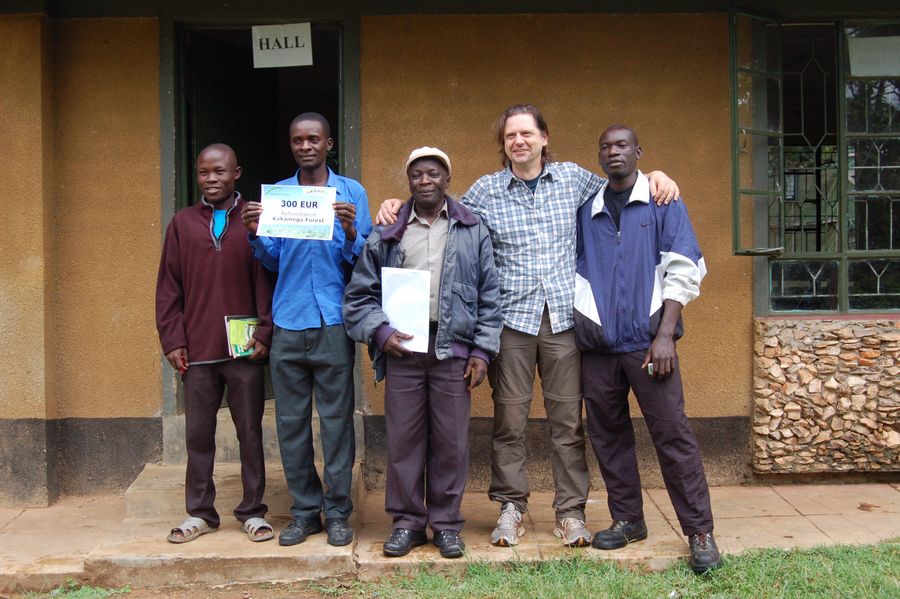First project meeting
The first project meeting was held on 14th,Jan.2010 and attended by KEEP Executive office members and Buyangu branch members, participating school teachers and local administration. Among the issues addressed in this meeting were Project management. On this issue, a team of four active members was constituted so that each was to be the supervisor of our participating school as follws:Shitirira Primary school –Ms Maximiller Achesa
Ingolomosio Sec. School—Mr. Jonathan Mukaisi
Kuvasali Primary school—Mr. Eliud Ingachi
Lunyu Primary school—Ms. Eldah Nyandika.
Tree nursery has a total of over 14,000 seedlings
The tree nursery already established by KEEP next to the Resource centre has a total of over 14,000 seedlings which gives this project an excellent opportunity to kick off. Though the seedlings were still too young but they were the right size as we have time till April to start transferring them to woodlots. However, KEEP decided to have a closer look to the selected seedlings so that they are healthy and fit for planting when tie comes. Watering was intensified, regular work improved in the seed bank e.g. weeding, cleanliness aong others. Three more mebers were added to the tree nursery staff to support with the work in this project. A duty roster was also drawn to ensure regular work is continuous in the tree nursery.Workshop with KEEP members, teachers, students, local administration and more
We conducted our first project workshop on 14th,Feb.2010 at KEEP resource centre and it was attended by anong others, KEEP members, teachers, pupil and students heads, local administration and forest tour guides. We had a total of 38 workshop participants and got soe experise from KEFRI (Kenya Forest Research Institute Maseno centre) Among the topics covered on this workshop were: - Seedling care and tree anagement. - Tree infections and basic treatments. - Woodlot establishment and security. - Tree point generation criteria.School selection in the pilot project
The selection of schools had already been done late last year in December. The following are the schools selected in the pilot project:Lunyu Primary school to the East of Kakamega Forest.
Kuvasali primary school to the far north.
Shtirira primary school to the North next to Malava Forest.
Ingolomosio secondary school to the East towards North Nandi Forest.
Pupils selection
The exercise to select pupils and student was carried out on 14th, Feb.2010 in all the schools in our project. In primary schools we targeted pupils in class 4 while in secondary we went for the students in Form 1. This was so due to the consideration of the time in years the pupils and students will be in the schools to take care of the seedlings. In fact this makes us confident that within the four or more years they will be in school, our seedlings will be stable. We further considered gender and selected 10 female and 10 male pupils/students in each school.Success and unexpected outcomes
This being our first project directly working with small children, we learnt that they are more interested in owning the trees than we expected. Some of them were telling us that we were giving them too few trees for enrichment but had to explain to them about budget allocation. The local community also feels quite happy about the project though they need a bit more explanation on who owns the trees in school. We told them that the trees belong to the school management but we take strict measures against cutting them as our major goal is to see forest products generated outside the forest. We have also gotten a number of applications from schools that do not participate in the programme and they also want to be in corporate. But due to our plan being a bit strict, we tell them that if things work out well, we might think of increasing the number of schools and even pupils.Challenges and solutions
The project started quite well though with no funds as we had not yet got money from nature fund. KEEP took care of all the initial stages till when we got the first installments then we had to reimburse. However, all in all, we encountered a number of challenges that came as an over site as follows:We did not plan for a digital camera and as a result, we hired some ones camera which we thought could be successful for our documentation but it failed us because we tried to download the pictures to the computer but it seems not working. This is if fact letting us to think of buying our own camera for the project.
We were given a laptop fro KEEP for our work but unfortunately, it stopped working as soon as we had recruited the school. Now we have to go all the way to cyber café for typing. We have therefore decided to train two members in computer usage so that we can cut costs of paying to be typed for especially when we get our own laptop.
The bicycles were of great help to get to the schools but at times when it rains, the roads become too muddy making it quite a challenge to travel to our sites but we have organized with some guys who have motor bikes for emergencies.
Concerning stationary, we did not consider extra note books and pens for patrons and KEEP members but the KEEP executive office took care of that and bought extra stationaries for the workshops.

